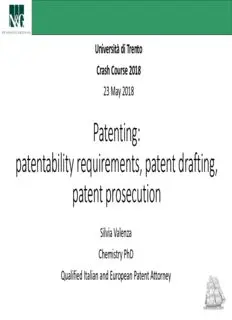
Silvia Valenza - Patenting: patentability requirements, patent drafting, patent prosecution PDF
Preview Silvia Valenza - Patenting: patentability requirements, patent drafting, patent prosecution
Università di Trento Crash Course 2018 23 May 2018 Patenting: patentability requirements, patent drafting, patent prosecution Silvia Valenza Chemistry PhD Qualified Italian and European Patent Attorney Content • Introduction to IP rights • Focus on patents • Patentability requirements • Patentable subject-matters • Novelty • Inventive step • Suffciency of disclosure • Patent drafting • Patenting procedure Introduction to IP rights One product, many IP rights Trade marks Patents and utility models NOKIA Data-processing methods Product "208" Operating system Start-up tone Operation of user interface Copyright Designs Software Form of overall phone User manuals Arrangement and shape of buttons Ringtones Position and shape of screen Start-up tone Images Trade secrets Some technical know-how kept © Nokia Corporation "in-house" and not published Overview of intellectual property Legal right What for? How? Original creative or Copyright Exists automatically artistic forms Distinctive identification Use and/or Trade marks of products or services registration Registered External appearance Registration* designs Valuable information Reasonable efforts Trade secrets not known to the public to keep secret Application and Patents New inventions examination Advantages and disadvantages of patenting Advantages Disdvantages • Exclusivity enables • Reveals invention investment and higher to competitors returns on investment (after 18 months) • Strong, enforceable legal • Can be expensive right • Patent enforceable only after • Makes invention tradable grant (this can take (licensing) 4-5 years) Alternatives to patenting Information disclosure (publishing) • Cheap • Does not offer exclusivity • Prevents others from • Reveals the invention to patenting the same invention competitors Secrecy (creating a trade secret) • Cheap (but there is the cost • No protection against reverse- of maintaining secrecy) engineering/duplication of invention • Does not reveal the invention • Difficult to enforce • "Secrets" often leak quite fast Do nothing • No effort required • Does not offer exclusivity • Competitors will often learn details How patents are used • Protecting products and processes • Increasing turnover and profits • Attracting investors • Licensing • Cross-licensing • Blocking competitors • Building reputation Licensing income of US universities Focus on what is a patent
